
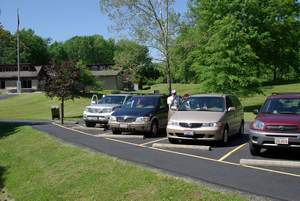
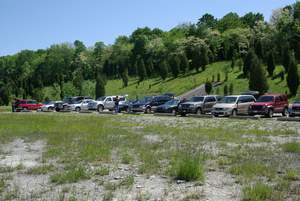
It was a perfect May day for the Dry Dredgers field trip to Harsha/East Fork Lake. This is a continuation of our 2008 field trip series to fossil sites we have not visited in a while. Our last visit was in 1999.
At Harsha/East Fork Lake, fossil collecting is permitted only
in the spillway and then only with permission. Persons wishing to collect
fossils sign in at the visitor center located near the dam. So that is where we
met that day before proceeding to the site.



Once everyone was there, we proceeded to the spillway. This spillway is an extremely large flat area that exposes the Fairview Formation.
This site was chosen for May as a good site for families. And as anticipated, young and old alike turned out to find that elusive trilobite and quantities of common gastropods.
Fossils Found That Day
Crinoids
Quite a few crinoid fossils were
found. This first one is a crinoid arm with pinnules on the surface of a rock.
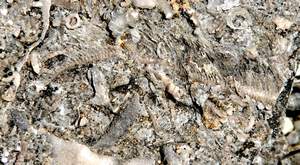
Then someone found a calyx (head) of
Ectenocrinus
simplex (next 2 pics)
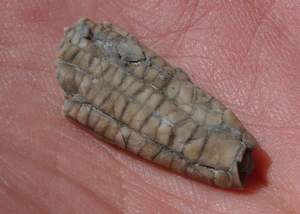
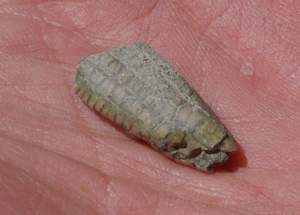
Among the
crinoid holdfasts
found what this interesting specimen where a crinoid stem is wrapped around a Bryozoan.
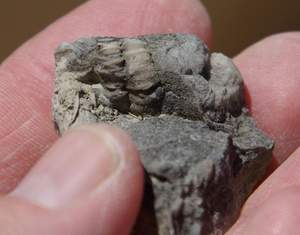
Also found were individual plates from a crinoid calyx.
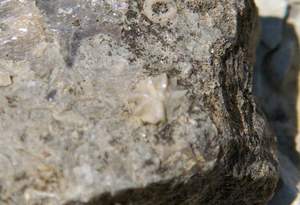
Most fragments of crinoids, though, were stems, some
articulated on a rock surface like the one below.
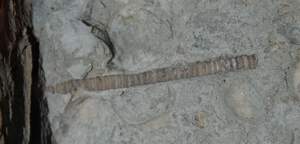
Bryozoans
Being a good exposure of the Fairview Formation, a few
examples of an interesting Bryozoan that is mostly limited to the Fairview
Formation were found, Escharopora falciformis. These spear-shaped
bryos have monticules (holes) that are diamond shaped.
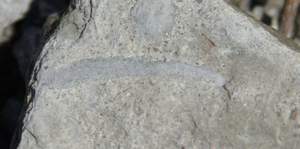
Another interesting bryozoan was a ramose (branching) variety
with stellate (star shaped) monticules, Constellaria florida.
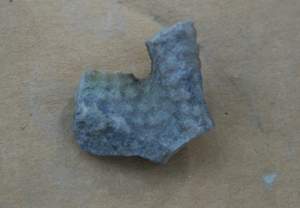
These ramose bryozoans can be found in large colonies, the
gaps of which have been filled in with rock matrix.
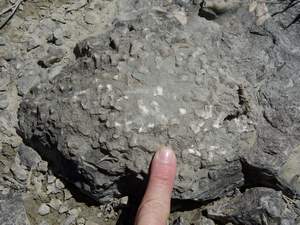
Brachiopods
On this site there are layers in which you can find a very
collectable brachiopod that is somewhat limited
to the Fairview formation, Plectorthis fissicosta.(next 2 pics).
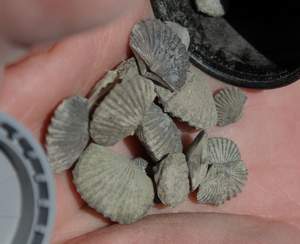
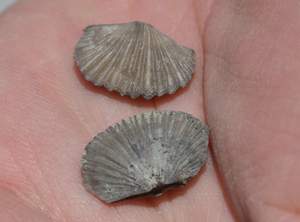
Not sure about this one. It looks more like a Glyptorthis,
but it's from the Fairview formation. It could be a Plectorthis, but the hinge
is not flat enough. Any thoughts from the viewers?
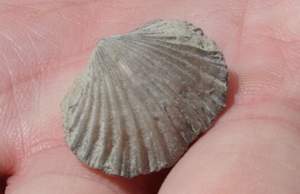
More common are the plentiful brachiopod, Vinlandostrophia
(several species: next 2 pics). Most were P. hopensis.
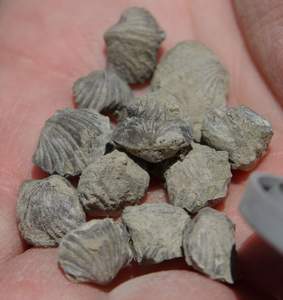
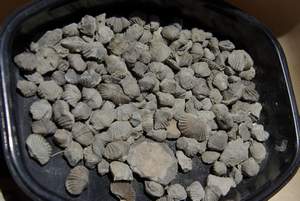
A few nice Trematis millepunctata were found. These are
inarticulate brachipods that have a white residue that shows some of the tiny
holes that made up the surface of this brach.
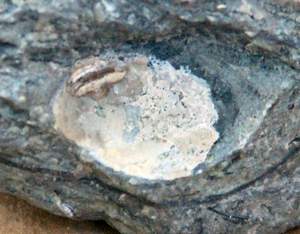
Most of the Hebertella we found were broken and on rock surfaces.
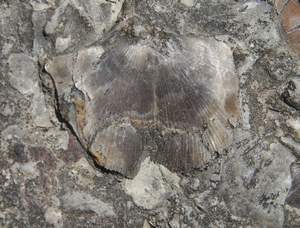
The site was not without Vinlandostrophia ponderosa. But they were not as common as
what we are used to in the Bellevue Formation which was not exposed here except
for on the hill tops above the spillway where collecting is not permitted.
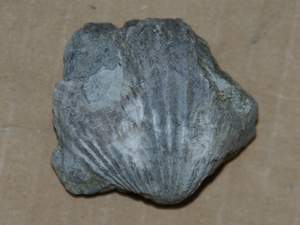
Trilobites
Not much in the way of Flexicalymene trilobites were found. But
this site was great for plenty of large fragments of the trilobite Isotelus.
The first 3 pictures show some of the Hypostomes (mouth plates) that were
found.
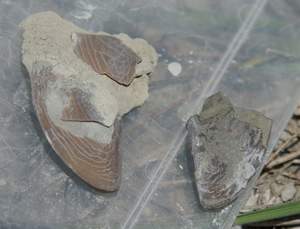
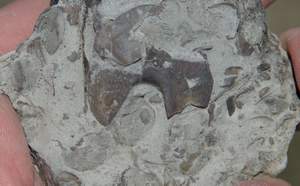
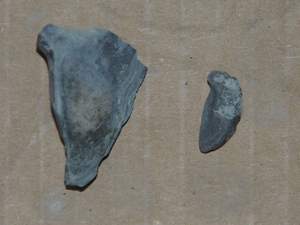
Here's a nice fragment of the thorax, showing some of the 8
segments Isotelus have.
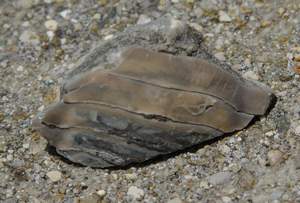
Other fragments were from the genal area (next 4 pics).
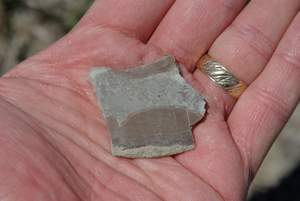
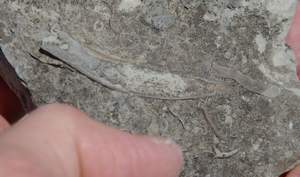
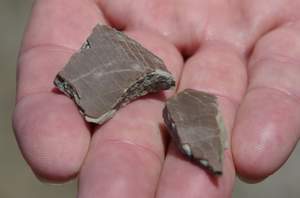
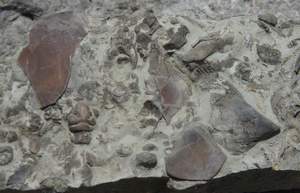
Gastropods
This site was great for large quantities of gastropods. The
most common was Paupospira. (next 3 pics)
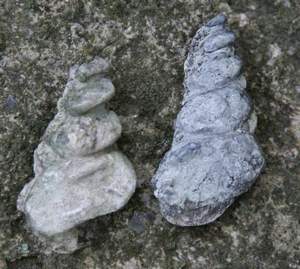
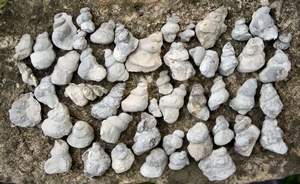
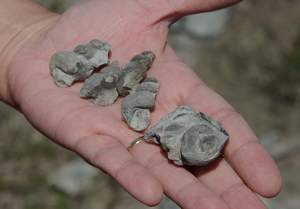
The next common Gastropod found was Cyclonema.
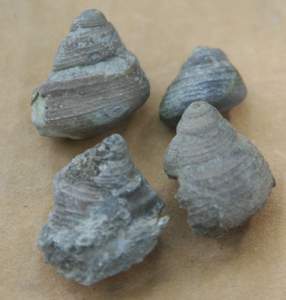
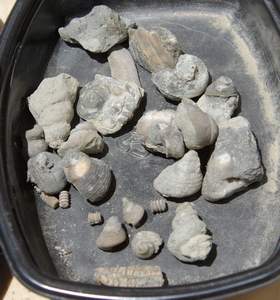
Internal molds of gastropods abounded. Even cross sections of
rocks showed the interesting patterns created by these snail shells, partially
replaced by calcite crystals.
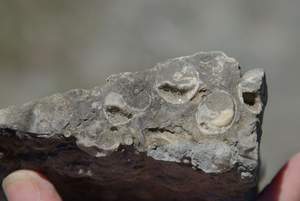
Most internal molds were free from the rock matrix and all
over the ground.
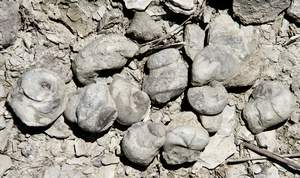
Cephalopods
Not many specimens of the often plentiful straight-shelled
nautiloid cephalopod were found. Here's one though.
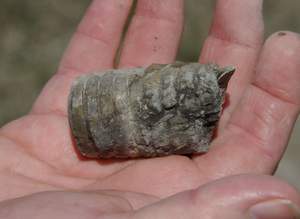
Trace Fossils
As is true for most Fairview Formation sites, we found
examples of trace fossils on the surface of rocks. There is a particularly
strange variety that keeps popping up on the sites we visit. The example shown
below has straight, 3-sided and 4-sided burrows that taper to a point. It is a
very distinct shape. The burrows are randomly distributed.
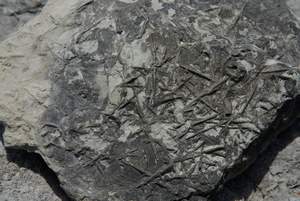
See Photos of this same trace at another site in 2005
Pelecypods (clams)
A few internal molds of clams were found. (Hey, is that a tail
section of an Isotelus trilobite??!! I've got to look closer at
what members find when I'm taking the pictures. I often draw a different
conclusion when looking at the photos later.)
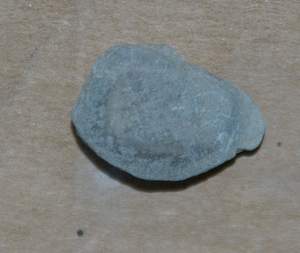
Crustaceans
And finally, a more recent fossil found on the lake spillway
floor. Similar to trilobites, this crayfish is a molt, not a dead animal.
Crustaceans shed their exoskeletons periodically, leaving molts that look like
the complete animal. Check your trilobite fossils, folks. They could be just one
of many molts the animal shed in it's lifetime.
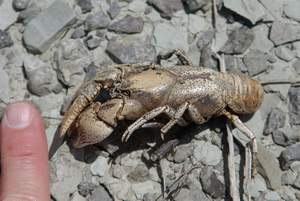
That's it for this field trip. Hope you enjoyed it as much as we did out there.
Next field trip: June 2008: Penn Dixie Site, NY
Return to Dry Dredgers Home Page
The Dry Dredgers and individual contributors reserve the
rights to all information, images, and content presented here. Permission to
reproduce in any fashion, must be requested in writing to admin@drydredgers.org.
www.drydredgers.org is designed and maintained by Bill Heimbrock.